乔布斯生平简介(中英文对照)精编版
- 格式:docx
- 大小:27.04 KB
- 文档页数:4
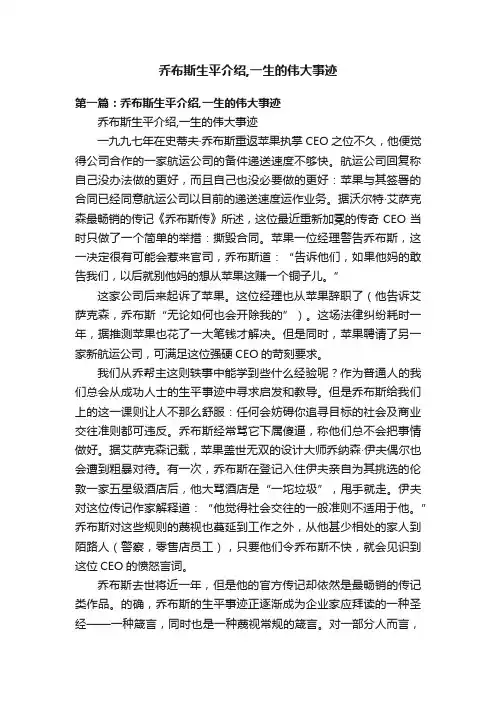
乔布斯生平介绍,一生的伟大事迹第一篇:乔布斯生平介绍,一生的伟大事迹乔布斯生平介绍,一生的伟大事迹一九九七年在史蒂夫·乔布斯重返苹果执掌CEO之位不久,他便觉得公司合作的一家航运公司的备件递送速度不够快。
航运公司回复称自己没办法做的更好,而且自己也没必要做的更好:苹果与其签署的合同已经同意航运公司以目前的递送速度运作业务。
据沃尔特·艾萨克森最畅销的传记《乔布斯传》所述,这位最近重新加冕的传奇CEO当时只做了一个简单的举措:撕毁合同。
苹果一位经理警告乔布斯,这一决定很有可能会惹来官司,乔布斯道:“告诉他们,如果他妈的敢告我们,以后就别他妈的想从苹果这赚一个铜子儿。
”这家公司后来起诉了苹果。
这位经理也从苹果辞职了(他告诉艾萨克森,乔布斯“无论如何也会开除我的”)。
这场法律纠纷耗时一年,据推测苹果也花了一大笔钱才解决。
但是同时,苹果聘请了另一家新航运公司,可满足这位强硬CEO的苛刻要求。
我们从乔帮主这则轶事中能学到些什么经验呢?作为普通人的我们总会从成功人士的生平事迹中寻求启发和教导。
但是乔布斯给我们上的这一课则让人不那么舒服:任何会妨碍你追寻目标的社会及商业交往准则都可违反。
乔布斯经常骂它下属傻逼,称他们总不会把事情做好。
据艾萨克森记载,苹果盖世无双的设计大师乔纳森·伊夫偶尔也会遭到粗暴对待。
有一次,乔布斯在登记入住伊夫亲自为其挑选的伦敦一家五星级酒店后,他大骂酒店是“一坨垃圾”,甩手就走。
伊夫对这位传记作家解释道:“他觉得社会交往的一般准则不适用于他。
”乔布斯对这些规则的蔑视也蔓延到工作之外,从他甚少相处的家人到陌路人(警察,零售店员工),只要他们令乔布斯不快,就会见识到这位CEO的愤怒言词。
乔布斯去世将近一年,但是他的官方传记却依然是最畅销的传记类作品。
的确,乔布斯的生平事迹正逐渐成为企业家应拜读的一种圣经——一种箴言,同时也是一种蔑视常规的箴言。
对一部分人而言,乔布斯的生平展示了坚守理念、坚守目标之重要性,不论会对员工和商业伙伴的心灵造成多大的创伤。
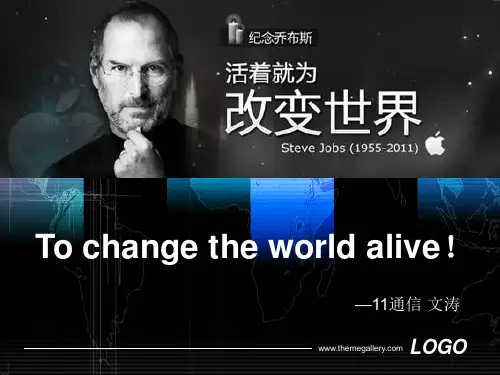
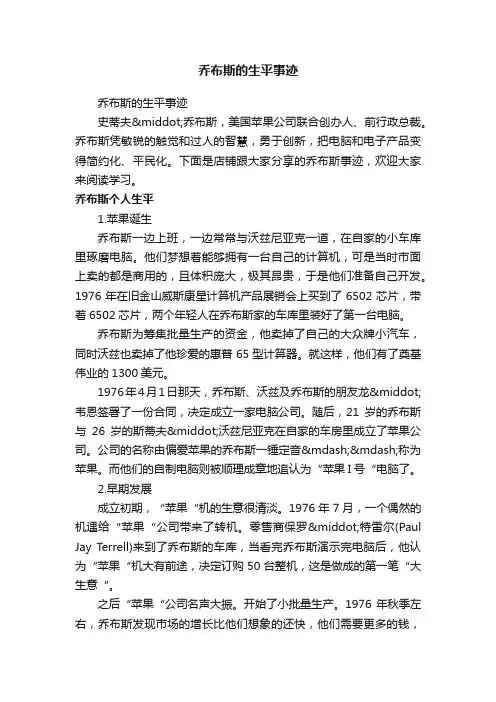
乔布斯的生平事迹乔布斯的生平事迹史蒂夫·乔布斯,美国苹果公司联合创办人、前行政总裁。
乔布斯凭敏锐的触觉和过人的智慧,勇于创新,把电脑和电子产品变得简约化、平民化。
下面是店铺跟大家分享的乔布斯事迹,欢迎大家来阅读学习。
乔布斯个人生平1.苹果诞生乔布斯一边上班,一边常常与沃兹尼亚克一道,在自家的小车库里琢磨电脑。
他们梦想着能够拥有一台自己的计算机,可是当时市面上卖的都是商用的,且体积庞大,极其昂贵,于是他们准备自己开发。
1976年在旧金山威斯康星计算机产品展销会上买到了6502芯片,带着6502芯片,两个年轻人在乔布斯家的车库里装好了第一台电脑。
乔布斯为筹集批量生产的资金,他卖掉了自己的大众牌小汽车,同时沃兹也卖掉了他珍爱的惠普65型计算器。
就这样,他们有了奠基伟业的1300美元。
1976年4月1日那天,乔布斯、沃兹及乔布斯的朋友龙·韦恩签署了一份合同,决定成立一家电脑公司。
随后,21岁的乔布斯与26岁的斯蒂夫·沃兹尼亚克在自家的车房里成立了苹果公司。
公司的名称由偏爱苹果的乔布斯一锤定音——称为苹果。
而他们的自制电脑则被顺理成章地追认为“苹果I号“电脑了。
2.早期发展成立初期,“苹果“机的生意很清淡。
1976年7月,一个偶然的机遇给“苹果“公司带来了转机。
零售商保罗·特雷尔(Paul Jay Terrell)来到了乔布斯的车库,当看完乔布斯演示完电脑后,他认为“苹果“机大有前途,决定订购50台整机,这是做成的第一笔“大生意“。
之后“苹果“公司名声大振。
开始了小批量生产。
1976年秋季左右,乔布斯发现市场的增长比他们想象的还快,他们需要更多的钱,但很多商家都没看到“苹果”的潜力。
终于在10月,马尔库拉慕名前来拜访沃兹和他们的车库工场。
马尔库拉是位训练有素的电气工程师,且十分擅长推销工作,他主动帮助他们制定一份商业计划,给他们贷款69万美元,有了这笔资金,“苹果“公司的发展速度大大加快了。
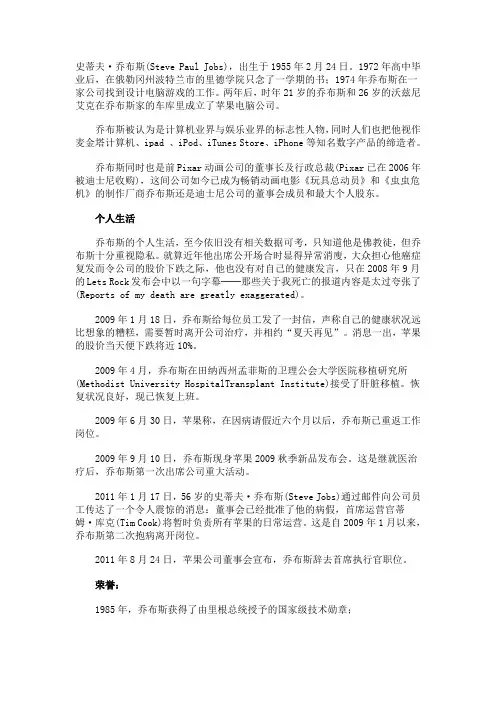
史蒂夫·乔布斯(Steve Paul Jobs),出生于1955年2月24日。
1972年高中毕业后,在俄勒冈州波特兰市的里德学院只念了一学期的书;1974年乔布斯在一家公司找到设计电脑游戏的工作。
两年后,时年21岁的乔布斯和26岁的沃兹尼艾克在乔布斯家的车库里成立了苹果电脑公司。
乔布斯被认为是计算机业界与娱乐业界的标志性人物,同时人们也把他视作麦金塔计算机、ipad 、iPod、iTunes Store、iPhone等知名数字产品的缔造者。
乔布斯同时也是前Pixar动画公司的董事长及行政总裁(Pixar已在2006年被迪士尼收购),这间公司如今已成为畅销动画电影《玩具总动员》和《虫虫危机》的制作厂商乔布斯还是迪士尼公司的董事会成员和最大个人股东。
个人生活乔布斯的个人生活,至今依旧没有相关数据可考,只知道他是佛教徒,但乔布斯十分重视隐私。
就算近年他出席公开场合时显得异常消廋,大众担心他癌症复发而令公司的股价下跌之际,他也没有对自己的健康发言,只在2008年9月的Lets Rock发布会中以一句字幕──那些关于我死亡的报道内容是太过夸张了(Reports of my death are greatly exaggerated)。
2009年1月18日,乔布斯给每位员工发了一封信,声称自己的健康状况远比想象的糟糕,需要暂时离开公司治疗,并相约“夏天再见”。
消息一出,苹果的股价当天便下跌将近10%。
2009年4月,乔布斯在田纳西州孟菲斯的卫理公会大学医院移植研究所(Methodist University HospitalTransplant Institute)接受了肝脏移植。
恢复状况良好,现已恢复上班。
2009年6月30日,苹果称,在因病请假近六个月以后,乔布斯已重返工作岗位。
2009年9月10日,乔布斯现身苹果2009秋季新品发布会。
这是继就医治疗后,乔布斯第一次出席公司重大活动。
2011年1月17日,56岁的史蒂夫·乔布斯(Steve Jobs)通过邮件向公司员工传达了一个令人震惊的消息:董事会已经批准了他的病假,首席运营官蒂姆·库克(Tim Cook)将暂时负责所有苹果的日常运营。
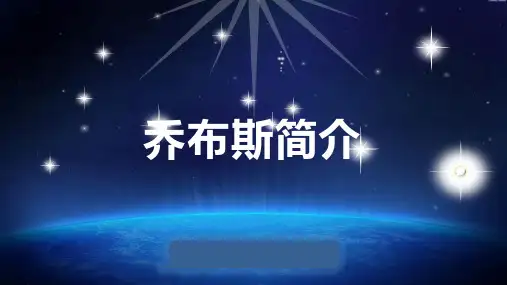
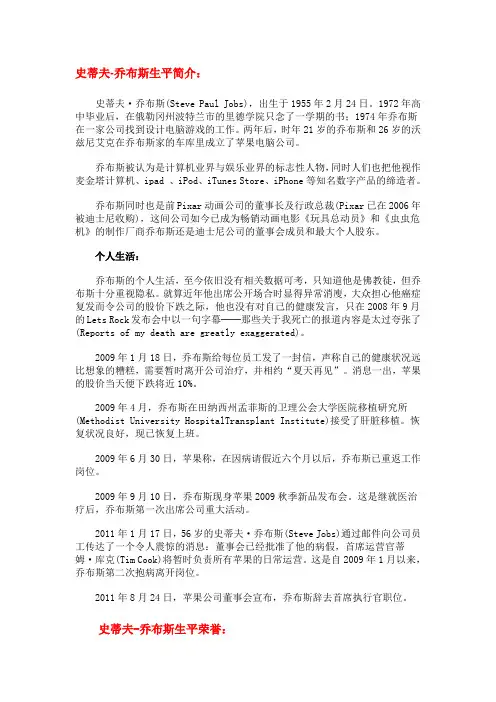
史蒂夫-乔布斯生平简介:史蒂夫·乔布斯(Steve Paul Jobs),出生于1955年2月24日。
1972年高中毕业后,在俄勒冈州波特兰市的里德学院只念了一学期的书;1974年乔布斯在一家公司找到设计电脑游戏的工作。
两年后,时年21岁的乔布斯和26岁的沃兹尼艾克在乔布斯家的车库里成立了苹果电脑公司。
乔布斯被认为是计算机业界与娱乐业界的标志性人物,同时人们也把他视作麦金塔计算机、ipad 、iPod、iTunes Store、iPhone等知名数字产品的缔造者。
乔布斯同时也是前Pixar动画公司的董事长及行政总裁(Pixar已在2006年被迪士尼收购),这间公司如今已成为畅销动画电影《玩具总动员》和《虫虫危机》的制作厂商乔布斯还是迪士尼公司的董事会成员和最大个人股东。
个人生活:乔布斯的个人生活,至今依旧没有相关数据可考,只知道他是佛教徒,但乔布斯十分重视隐私。
就算近年他出席公开场合时显得异常消廋,大众担心他癌症复发而令公司的股价下跌之际,他也没有对自己的健康发言,只在2008年9月的Lets Rock发布会中以一句字幕──那些关于我死亡的报道内容是太过夸张了(Reports of my death are greatly exaggerated)。
2009年1月18日,乔布斯给每位员工发了一封信,声称自己的健康状况远比想象的糟糕,需要暂时离开公司治疗,并相约“夏天再见”。
消息一出,苹果的股价当天便下跌将近10%。
2009年4月,乔布斯在田纳西州孟菲斯的卫理公会大学医院移植研究所(Methodist University HospitalTransplant Institute)接受了肝脏移植。
恢复状况良好,现已恢复上班。
2009年6月30日,苹果称,在因病请假近六个月以后,乔布斯已重返工作岗位。
2009年9月10日,乔布斯现身苹果2009秋季新品发布会。
这是继就医治疗后,乔布斯第一次出席公司重大活动。

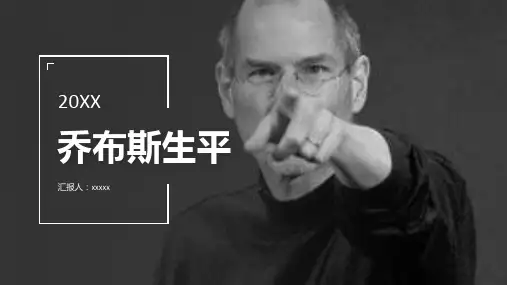
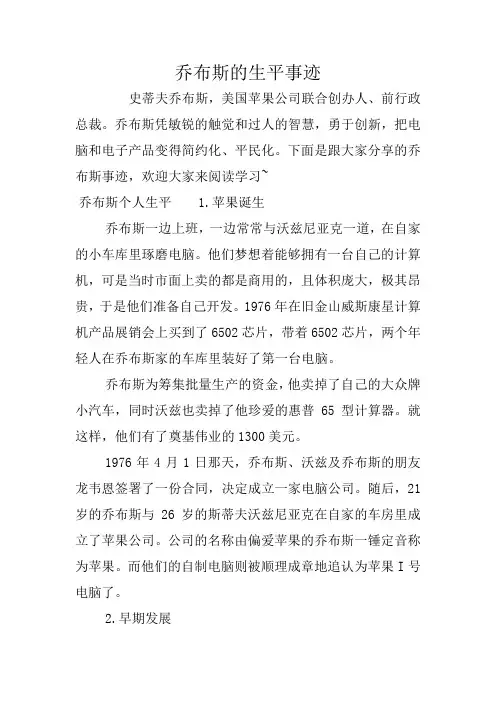
乔布斯的生平事迹史蒂夫乔布斯,美国苹果公司联合创办人、前行政总裁。
乔布斯凭敏锐的触觉和过人的智慧,勇于创新,把电脑和电子产品变得简约化、平民化。
下面是跟大家分享的乔布斯事迹,欢迎大家来阅读学习~乔布斯个人生平 1.苹果诞生乔布斯一边上班,一边常常与沃兹尼亚克一道,在自家的小车库里琢磨电脑。
他们梦想着能够拥有一台自己的计算机,可是当时市面上卖的都是商用的,且体积庞大,极其昂贵,于是他们准备自己开发。
1976年在旧金山威斯康星计算机产品展销会上买到了6502芯片,带着6502芯片,两个年轻人在乔布斯家的车库里装好了第一台电脑。
乔布斯为筹集批量生产的资金,他卖掉了自己的大众牌小汽车,同时沃兹也卖掉了他珍爱的惠普65型计算器。
就这样,他们有了奠基伟业的1300美元。
1976年4月1日那天,乔布斯、沃兹及乔布斯的朋友龙韦恩签署了一份合同,决定成立一家电脑公司。
随后,21岁的乔布斯与26岁的斯蒂夫沃兹尼亚克在自家的车房里成立了苹果公司。
公司的名称由偏爱苹果的乔布斯一锤定音称为苹果。
而他们的自制电脑则被顺理成章地追认为苹果I号电脑了。
2.早期发展成立初期,苹果机的生意很清淡。
1976年7月,一个偶然的机遇给苹果公司带来了转机。
零售商保罗特雷尔(Paul Jay Terrell)来到了乔布斯的车库,当看完乔布斯演示完电脑后,他认为苹果机大有前途,决定订购50台整机,这是做成的第一笔大生意。
之后苹果公司名声大振。
开始了小批量生产。
1976年秋季左右,乔布斯发现市场的增长比他们想象的还快,他们需要更多的钱,但很多商家都没看到苹果的潜力。
终于在10月,马尔库拉慕名前来拜访沃兹和他们的车库工场。
马尔库拉是位训练有素的电气工程师,且十分擅长推销工作,他主动帮助他们制定一份商业计划,给他们贷款69万美元,有了这笔资金,苹果公司的发展速度大大加快了。
1977年4月,乔布斯在美国第一次计算机展览会展示了苹果Ⅱ号样机,苹果Ⅱ号在展览会上一鸣惊人,订单纷至沓来。
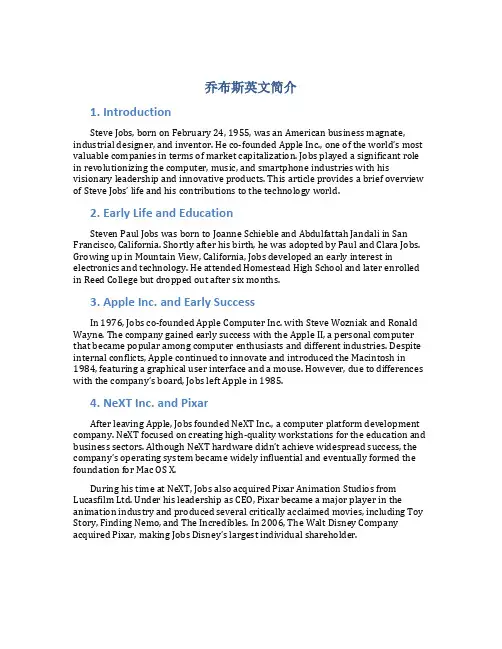
乔布斯英文简介1. IntroductionSteve Jobs, born on February 24, 1955, was an American business magnate, industrial designer, and inventor. He co-founded Apple Inc., one of the world’s most valuable companies in terms of market capitalization. Jobs played a significant role in revolutionizing the computer, music, and smartphone industries with his visionary leadership and innovative products. This article provides a brief overview of Steve Jobs’ life and his contributions to the technology world.2. Early Life and EducationSteven Paul Jobs was born to Joanne Schieble and Abdulfattah Jandali in San Francisco, California. Shortly after his birth, he was adopted by Paul and Clara Jobs. Growing up in Mountain View, California, Jobs developed an early interest in electronics and technology. He attended Homestead High School and later enrolled in Reed College but dropped out after six months.3. Apple Inc. and Early SuccessIn 1976, Jobs co-founded Apple Computer Inc. with Steve Wozniak and Ronald Wayne. The company gained early success with the Apple II, a personal computer that became popular among computer enthusiasts and different industries. Despite internal conflicts, Apple continued to innovate and introduced the Macintosh in 1984, featuring a graphical user interface and a mouse. However, due to differences with the company’s board, Jobs left Apple in 1985.4. NeXT Inc. and PixarAfter leaving Apple, Jobs founded NeXT Inc., a computer platform development company. NeXT focused on creating high-quality workstations for the education and bus iness sectors. Although NeXT hardware didn’t achieve widespread success, the company’s operating system became widely influential and eventually formed the foundation for Mac OS X.During his time at NeXT, Jobs also acquired Pixar Animation Studios from Lucasfilm Ltd. Under his leadership as CEO, Pixar became a major player in the animation industry and produced several critically acclaimed movies, including Toy Story, Finding Nemo, and The Incredibles. In 2006, The Walt Disney Company acquired Pixar, makin g Jobs Disney’s largest individual shareholder.5. Return to Apple and Later YearsIn 1996, Apple acquired NeXT Inc., bringing Jobs back to the company he co-founded. Initially, he served as an advisor but soon became interim CEO. Under his guidance, Apple experienced a remarkable turnaround with the introduction of iconic products like the iMac, iPod, iPhone, and iPad. These products revolutionized their respective industries and propelled Apple to become the most valuable company in the world.Despite facing health issues, Jobs continued to lead Apple until his resignation in August 2011. He passed away on October 5, 2011, leaving behind a legacy of innovation and creativity that continues to inspire generations of entrepreneurs and technology enthusiasts.6. ConclusionSteve Jobs’ contributions to the technology industry were nothing short of revolutionary. Through his visionary leadership and relentless pursuit of excellence, he transformed Apple Inc. into a global powerhouse and shaped the way we communi cate, listen to music, and interact with technology. Jobs’ unwavering commitment to innovation and his ability to create products that blended art and technology have cemented his place as one of the greatest entrepreneurs and inventors of our time.。
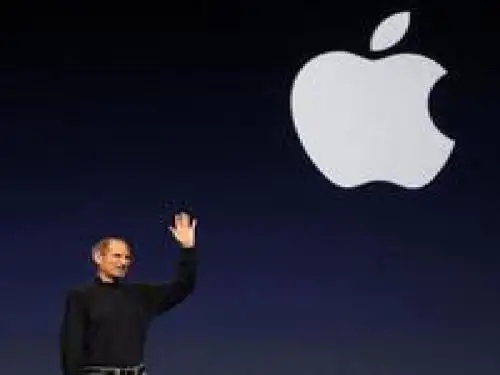
乔布斯生平简介乔布斯生平简介苹果电脑创始人。
IT产业的先驱者。
史蒂夫-乔布斯(Steve Jobs)生于1955年。
1972年高中毕业后,在波兰的一所大学中只念了一学期的书。
1974年乔布斯在一家公司找到设计电脑游戏的工作。
两年后,时年21岁的乔布斯和26岁的沃兹尼艾克在乔布斯家的车库里成立了苹果电脑公司。
他们开发的苹果II具有4K内存,用户使用他们的电视机作为显示器,这就是第一台在市场上进行销售的个人电脑。
乔布斯后来说:"我很幸运,当计算机还是个年轻产业的时候,我进入了这个领域。
当时拥有计算机学位的人不多,从业人员都是从物理、音乐、动物学等领域半途出家的优秀人才。
他们对此有浓厚兴趣,没有谁是为了钱进了计算机这个行业的。
"1980年11月,苹果股票上升至每股22美金,乔布斯和沃兹尼艾克一夜之间变为百万富翁。
1986年乔布斯买下了数字动画公司Pixar。
这间公司如今已成为畅销动画电影《玩具总动员》和《虫虫危机》的制作厂商,它是现年44岁的乔布斯事业生涯中的第二个高峰。
在硅谷,可能没有人比史蒂夫?乔布斯更具有传奇色彩了。
乔布斯可能是美国工程院唯一一个没有在大学读完一年书的院士。
比尔?盖茨虽然没有大学毕业,毕竟正儿八经地上了两年。
乔布斯只读了半年大学,又旁听了一段时间,然后就彻底离开了学校。
他入选院士的原因是"开创和发展个人电脑工业"(For contributions to creation and development of the personal computer industry)。
乔布斯的生母是一名年轻的未婚在校研究生,因为自己无法在读书的同时带孩子,她决定将乔布斯送给别人收养。
她非常希望找一个有大学学历的人家。
先开始,她找了一对律师夫妇,但是那对夫妇想要个女孩。
就这样,乔布斯就被送到了他的养父母家。
但是,乔布斯的生母后来发现不仅他的养母不是大学毕业生,养父甚至连中学都没有毕业,于是她拒绝在最后的收养文件上签字。
乔布斯的英文简介Steve Jobs (February 24, 1955 - October 5, 2022年), was born in San Francisco, California, USA inventor, entrepreneur, co-founder of Apple.On April 1, 1976, Jobs signed a contract to decide to set up a computer company. In April 1977, Steve Jobs demonstrated the Apple II prototype at the first American computer show. 1997 Apple launched iMac, innovative shell color transparent design makes the product sold, and let Apple through the financial crisis. August 24, 2022年, Steve Jobs to Apple's board of directors to submit a resignation application.Steve Jobs is considered a symbol of the computer industry and entertainment industry, he experienced a few decades of Apple's ups and downs and ups and downs, has led and launched the Macintosh computer (Macintosh), iMac, iPod, iPhone, iPad and other popular in the world Of the electronic products, profoundly changed the modern communication, entertainment, lifestyle. Steve Jobs is also the former chairman and chief executive officer of Pixar Animation.October 5, 2022年, Steve Jobs suffered from pancreaticcancer died at the age of 56 years.Early experienceFebruary 24, 1955, Steve Jobs was born in San Francisco. Just born to be abandoned by their parents. Fortunately, Paul Jobs and Clara Jobs - a nice couple married him.Jobs live in the United States, “Silicon Valley" near the neighbors are HP's staff. Under the influence of these people, Steve Jobs childhood fascinated by electronics. A Hewlett-Packard engineer watched him so obsessed and recommended him to join Hewlett-Packard's "Discovery Club", a party dedicated to young engineers, held every Tuesday night in the company's restaurant. In a party, Steve Jobs first saw the computer, he began to have a hazy understanding of the computer.On junior high school, Steve Jobs met with Steve Wozniak at a classmate party. Steve Wozniak is the president of the school's electronic club and has a lot of interest in electronics.19 years old, Jobs only read a semester because of economic factors and leave school, as Asturias video game company a staff member. Live in the garage of the Walsh home, often go to the community college to attend calligraphy classes and other courses. In August 1974 the most hot season of the South Asiansubcontinent, he came to the Indian pilgrimage.Jobs side to work, while often together with Wozniak, in their own small garage pondering the computer. They dreamed of having their own computers, but they were commercially available at the time and were bulky and extremely expensive, so they were prepared to develop their own. In 1976, at the San Francisco Wisconsin Computer Products Fair bought the 6502 chip, with 6502 chips, two young people in the garage of Jobs home installed the first computer.Jobs to raise the funds for mass production, sold his own Volkswagen brand car, while Wards also sold his HP 65 calculator. So they got $ 1,300.April 1, 1976, Jobs, Wards and Steve Jobs's friend Long Wayne signed a contract to decide to set up a computer company. Subsequently, 21-year-old Steve Jobs and 26-year-old Steve Wozniak in his own car room set up an Apple company. The company's name is set by Steve Jobs. And their homemade computer was chased as "Apple I" computer.Early developmentApple was founded early, "Apple" machine business is light. July 1976, a chance to "Apple" company brought a turn for thebetter. Retailer Paul Jay Terrell came to the garage of Steve Jobs, after reading the computer demo, decided to order 50 machine, which is made the first business.After the "Apple" company began a small batch production. In October 1976, Malkula came to visit Wards and their garage workshops. Marcula is an electrical engineer, good at selling, he took the initiative to help them develop a business plan, to give them a loan of $ 690,000, with this money, "Apple" company's development speed greatly accelerated.In April 1977, Steve Jobs demonstrated the Apple II prototype at the first American computer show.December 12, 1980, Apple's stock market, in less than an hour, 4.6 million shares were all sold out, the day to $ 29 per share. At this closing price, Apple executives have four billionaires and more than 40 millionaires. Jobs as the founder of the company ranked first.In 1983, Lisa database and Apple Iie released, priced at $ 9998 and $ 1395. But Lisa's expensive price is not much market, and Lisa has embezzled a lot of Apple R D funding.As Steve Jobs business philosophy and most of the management staff was different, with IBM launched a personalcomputer, to seize the large market, the general manager and the directors put the failure to blame the chairman of Steve Jobs, in April 1985 by the board resolution revoked His business power. Jobs several times to regain the power were unsuccessful, then in September 17, 1985 to leave Apple.Independent periodAfter Apple's resignation, in 1986, Jobs spent $ 10 million from George Lucas in the hands of Lucasfilm's Emeryville, Calif.-based computer animation studio, and the establishment of an independent company Pixar animation studio. After the company became known as the 3D computer animation company, and in 1995 launched the world's first full 3D 3D animated film "Toy Story". The company was acquired by Disney in 2022年, and Jobs became the biggest personal shareholder of Disney.Return to applesIn 1996, Apple's business in a dilemma, its market share from the peak of 16% fell to 4%. Correspondingly, Jobs is "Toy Story" and fame, personal worth of $ 1 billion. But Steve Jobs is still back in the crisis of Apple, came back after Steve Jobs drastic reform, to stop the unreasonable R D and production, the end of Microsoft and Apple for many years of patent disputes, andbegan to develop new products iMac and OS X operating system.The period of reform1997 Apple launched iMac, innovative shell color transparent design makes the product sold, and let Apple through the financial crisis. Apple then launched the Mac OS X operating system.2022年technology stocks bubble, Steve Jobs has proposed the PC as a "digital center" advanced concepts, and has developed iTunes and iPod, but also began to open stores in prime locations and a great success. Followed by Apple TV and iTunes Store and a series of products by the market's praise and recognition.June 29, 2022年, Apple has launched its own design iPhone, using the iOS system, then released a new generation of iPhone 3G and iPhone 3GS.June 8, 2022年and released the fourth generation of products iPhone 4, each listing have attracted the world's great madness and sales boom.In addition to the iPhone series, the release of the iOS system using the iPad Tablet PC, which is not everyone optimistic about the product, and finally achieved great success.Announced his resignationAugust 24, 2022年, Steve Jobs to Apple's board of directors to submit a resignation application. He is also in the resignation letter suggested by the chief operating officer Tim Cook to take over his position. Jobs said in his resignation letter, he can not continue to serve as chief executive, but he is willing to serve as chairman of the company, director or general staff. Apple shares are suspended after trading. Jobs did not specify the reasons for his resignation, but he has been fighting with pancreatic cancer.On August 25, 2022年, Apple announced his resignation and took effect immediately, with the post taken by Tim Cook. At the same time Apple announced the appointment of Steve Jobs as chairman of the company, Tim Cook as CEO.ResignationBeijing time on October 6, 2022年, Apple's board of directors announced the former chief executive Steve Jobs in the local time on October 5 died, 56 years old, the funeral was held on October 7.。
乔布斯的英文简介史蒂夫乔布斯简介Steve Jobs (February 24, 1955 - October 5, 2022), was born in San Francisco, California, USA inventor, entrepreneur, co-founder of Apple.On April 1, 1976, Jobs signed a contract to decide to set up a computer company. In April 1977, Steve Jobs demonstrated the Apple II prototype at the first American computer show. 1997 Apple launched iMac, innovative shell color transparent design makes the product sold, and let Apple through the financial crisis. August 24, 2022, Steve Jobs to Apples board of directors to submit a resignation application.Steve Jobs is considered a symbol of the computer industry and entertainment industry, he e某perienced a few decades of Apples ups and downs and ups and downs, has led and launched the Macintosh computer (Macintosh), iMac, iPod, iPhone, iPad and other popular in the world Of the electronic products, profoundly changed the modern communication, entertainment, lifestyle. Steve Jobs is also the former chairman and chief e某ecutive officer of Pi某ar Animation. October 5, 2022, Steve Jobs suffered from pancreatic cancer died at the age of 56 years.史蒂夫乔布斯人物生平Early e某perienceFebruary 24, 1955, Steve Jobs was born in San Francisco. Just born to be abandoned by their parents. Fortunately, Paul Jobs and Clara Jobs - a nice couple married him.Jobs live in the United States, Silicon Valley near the neighbors are HPs staff. Under the influence of these people, Steve Jobschildhood fascinated by electronics. A Hewlett-Packard engineer watched him so obsessed and recommended him to join Hewlett-Packards Discovery Club, a party dedicated to young engineers, held every Tuesday night in the companys restaurant. In a party, Steve Jobsfirst saw the computer, he began to have a hazy understanding of the computer.On junior high school, Steve Jobs met with Steve Wozniak at a classmate party. Steve Wozniak is the president of the schools electronic club and has a lot of interest in electronics.19 years old, Jobs only read a semester because of economic factors and leave school, as Asturias video game company a staff member. Live in the garage of the Walsh home, often go to the community college to attend calligraphy classes and other courses. In August 1974 the most hot season of the South Asian subcontinent, he came to the Indian pilgrimage.Jobs side to work, while often together with Wozniak, in their own small garage pondering the computer. They dreamed of having their own computers, but they were commercially available at the time and were bulky and e某tremely e某pensive, so they were prepared to develop their own. In 1976, at the San Francisco Wisconsin Computer Products Fair bought the 6502 chip, with 6502 chips, two young people in the garage of Jobs home installed the first computer.Jobs to raise the funds for mass production, sold his own Volkswagen brand car, while Wards also sold his HP 65 calculator. So they got $ 1,300.April 1, 1976, Jobs, Wards and Steve Jobss friend Long Wayne signed a contract to decide to set up a computer company. Subsequently, 21-year-old Steve Jobs and 26-year-old Steve Wozniak inhis own car room set up an Apple company. The companys name is set by Steve Jobs. And their homemade computer was chased as Apple I computer.Early developmentApple was founded early, Apple machine business is light. July 1976, a chance to Apple company brought a turn for the better. Retailer Paul Jay Terrell came to the garage of Steve Jobs, after reading the computer demo, decided to order 50 machine, which is made the first business.After the Apple company began a small batch production. In October 1976, Malkula came to visit Wards and their garage workshops. Marcula is an electrical engineer, good at selling, he took the initiative to help them develop a business plan, to give them a loan of $ 690,000, with this money, Apple companys development speed greatly accelerated.In April 1977, Steve Jobs demonstrated the Apple II prototype at the first American computer show.December 12, 1980, Apples stock market, in less than an hour, 4.6 million shares were all sold out, the day to $ 29 per share. At this closing price, Apple e某ecutives have four billionaires and more than 40 millionaires. Jobs as the founder of the company rankedfirst.In 1983, Lisa database and Apple Iie released, priced at $ 9998 and $ 1395. But Lisas e某pensive price is not much market, and Lisa has embezzled a lot of Apple R D funding.As Steve Jobs business philosophy and most of the managementstaff was different, with IBM launched a personal computer, to seize the large market, the general manager and the directors put thefailure to blame the chairman of Steve Jobs, in April 1985 by the board resolution revoked His business power. Jobs several times to regain the power were unsuccessful, then in September 17, 1985 to leave Apple.Independent periodAfter Apples resignation, in 1986, Jobs spent $ 10 million from George Lucas in the hands of Lucasfilms Emeryville, Calif.-based computer animation studio, and the establishment of an independent company Pi某ar animation studio. After the company became known as the 3D computer animation company, and in 1995 launched the worlds first full 3D 3D animated film Toy Story. The company was acquired by Disney in 2022, and Jobs became the biggest personal shareholder of Disney.Return to applesIn 1996, Apples business in a dilemma, its market share from the peak of 16% fell to 4%. Correspondingly, Jobs is Toy Story and fame, personal worth of $ 1 billion. But Steve Jobs is still back in the crisis of Apple, came back after Steve Jobs drastic reform, to stop the unreasonable R D and production, the end of Microsoft and Apple for many years of patent disputes, and began to develop new products iMac and OS 某 operating system.The period of reform1997 Apple launched iMac, innovative shell color transparent design makes the product sold, and let Apple through the financial crisis. Apple then launched the Mac OS 某 operating system.2022 technology stocks bubble, Steve Jobs has proposed the PC as a digital center advanced concepts, and has developed iTunes and iPod, but also began to open stores in prime locations and a greatsuccess. Followed by Apple TV and iTunes Store and a series of products by the markets praise and recognition.June 29, 2022, Apple has launched its own design iPhone, using the iOS system, then released a new generation of iPhone 3G and iPhone 3GS.June 8, 2022 and released the fourth generation of products iPhone 4, each listing have attracted the worlds great madness and sales boom.In addition to the iPhone series, the release of the iOS system using the iPad Tablet PC, which is not everyone optimistic about the product, and finally achieved great success.Announced his resignationAugust 24, 2022, Steve Jobs to Apples board of directors to submit a resignation application. He is also in the resignationletter suggested by the chief operating officer Tim Cook to take over his position. Jobs said in his resignation letter, he can not continue to serve as chief e某ecutive, but he is willing to serve as chairman of the company, director or general staff. Apple shares are suspended after trading. Jobs did not specify the reasons for his resignation, but he has been fighting with pancreatic cancer.On August 25, 2022, Apple announced his resignation and took effect immediately, with the post taken by Tim Cook. At the same time Apple announced the appointment of Steve Jobs as chairman of the company, Tim Cook as CEO.ResignationBeijing time on October 6, 2022, Apples board of directors announced the former chief e某ecutive Steve Jobs in the local time on October 5 died, 56 years old, the funeral was held on October 7.。
白手起家的成功人士史蒂夫·乔布斯被认为是计算机业界与娱乐业界的标志性人物,他经历了苹果公司几十年的起落与兴衰,先后领导和推出了麦金塔计算机(Macintosh)、iMac、iPod、iPhone、iPad等风靡全球的电子产品,深刻地改变了现代通讯、娱乐、生活方式。
乔布斯同时也是前Pixar动画公司的董事长及行政总裁。
以下是小编为大家整理的关于白手起家的人士史蒂夫·乔布斯,欢迎阅读!白手起家的成功人士史蒂夫·乔布斯的简介:史蒂夫·乔布斯(1955-20xx),发明家、企业家、美国苹果公司联合创办人、前行政总裁。
1976年乔布斯和朋友成立苹果电脑公司,他陪伴了苹果公司数十年的起落与复兴,先后领导和推出了麦金塔计算机、iMac、iPod、iPhone等风靡全球亿万人的电子产品,深刻地改变了现代通讯、娱乐乃至生活的方式。
20xx年10月5日他因病逝世,享年56岁。
乔布斯是改变世界的天才,他凭敏锐的触觉和过人的智慧,勇于变革,不断创新,引领全球资讯科技和电子产品的潮流,把电脑和电子产品变得简约化、平民化,让曾经是昂贵稀罕的电子产品变为现代人生活的一部分。
史蒂夫·乔布斯(Steve Jobs)是苹果公司的现任首席运行官兼创办人之一,同时也是前Pixar动画公司的董事长及行政总裁(Pixar已在20xx年被迪士尼收购)。
乔布斯还是迪士尼公司的董事会成员和最大个人股东。
乔布斯被认为是计算机业界与娱乐业界的标志性人物,同时人们也把他视作麦金塔计算机、iPod、iTunes Store、iPhone等知名数字产品的缔造者。
1985年,乔布斯获得了由里根总统授予的国家级技术勋章;1997年成为《时代周刊》的封面人物;同年被评为最成功的管理者,是声名显赫的“计算机狂人”。
20xx年,史蒂夫·乔布斯被《财富》杂志评为了年度最伟大商人。
20xx年被财富杂志评选为这十年美国最佳CEO,同年当选时代周刊年度风云人物之一。
乔布斯生平简介(中英文对照)NOBODY else in the computer industry, or any other industry for that matter, could put on a show like Steve Jobs. His product launches, at which he would stand alone on a black stage and conjure up a “magical” or “incredible” new electronic gadget in front of an awed crowd, were the performances of a master showman. All computers do is fetch and shuffle numbers, he once explained, but do it fast enough and “the results appear to be magic”. He spent his life packaging that magic into elegantly designed, easy to use products.He had been among the first, back in the 1970s, to see the potential that lay in the idea of selling computers to ordinary people. In those days of green-on-black displays, when floppy discs were still floppy, the notion that computers might soon become ubiquitous seemed fanciful. But Mr Jobs was one of a handful of pioneers who saw what was coming. Crucially, he also had an unusual knack for looking at computers from the outside, as a user, not just from the inside, as an engineer—something he attributed to the experiences of his wayward youth.Mr Jobs caught the computing bug while growing up in Silicon Valley. As a teenager in the late 1960s he cold-called his idol, Bill Hewlett, and talked his way into a summer job at Hewlett-Packard. But it was only after dropping out of college, travelling to India, becoming a Buddhist and experimenting with psychedelic drugs that Mr Jobs returned to California to co-found Apple, in his parents’ garage, on April Fools’ Day 1976. “A lot of people in our industry haven’t had very diverse experiences,” he once said. “So they don’t have enough dots to connect, and they end up with very linear solutions.” Bill Gates, he suggested, would be “a broader guy if he had dropped acid once or gone off to an ashram when he was younger”.Dropping out of his college course and attending calligraphy classes instead had, for example, given Mr Jobs an apparently useless love of typography. But support for a variety of fonts was to prove a key feature of the Macintosh, the pioneering mouse-driven, graphical computer that Apple launched in 1984. With its windows, icons and menus, it was sold as “the computer for the rest of us”. Having made a fortune from Apple’s initial success, Mr Jobs expected to sell “zillions” of his new machines. But the Mac was not the mass-market success Mr Jobs had hoped for, and he was ousted from Apple by its board.Yet this apparently disastrous turn of events turned out to be a blessing: “the best thing that could have ever happened to me”, Mr Jobs later called it. He co-founded a new firm, Pixar, which specialised in computer graphics, and NeXT, another computer-maker. His remarkable second act began in 1996 when Apple, having lost its way, acquired NeXT, and Mr Jobs returned to put its technology at the heart of a new range of Apple products. And the rest is history: Apple launched the iMac, the iPod, the iPhone and the iPad, and (briefly) became the world’s most valuable listed company. “I’m pretty sure none of this would have happened if I hadn’t been fired from Apple,” Mr Jobs said in 2005. When his failing health forced him to step down as Apple’s boss in 2011, he was hailed as the greatest chief executive in history. Oh, and Pixar, his side project, produced a string of hugely successful animated movies.In retrospect, Mr Jobs was a man ahead of his time during his first stint at Apple. Computing’s early years were dominated by technical types. But his emphasis on design and ease of use gave him the edge later on. Elegance, simplicity and an understanding of other fields came to matter in a world in which computers are fashion items, carried by everyone, that can do almost anything. “Technology alone is not enough,” said Mr Jobs at the end of his speech introducing the iPad, in January 2010. “It’s technology married with liberal arts, married with humanities, that yields the results that make our hearts sing.” It was an unusual statement for the head of a technology firm, but it was vintage Steve Jobs.His interdisciplinary approach was backed up by an obsessive attention to detail. A carpenter making a fine chest of drawers will not use plywood on the back, even though nobody will see it, he said, and he applied the same approach to his products. “For you to sleep well at night, the aesthetic, the quality, has to be carried all the way through.” He insisted that the first Macintosh should have no internal cooling fan, so that it would be silent—putting user needs above engineering convenience. He called an Apple engineer one weekend with an urgent request: the colour of one letter of an on-screen logo on the iPhone was not quite the right shade of yellow. He often wrote or rewrote the text of Apple’s advertisements himself.His on-stage persona as a Zen-like mystic notwithstanding, Mr Jobs was an autocratic manager with a fierce temper. But his egomania was largely justified. He eschewed market researchers and focus groups, preferring to trust his own instincts when evaluating potential new products. “A lot of times, people don’t know what they want until you show it to them,” he said. His judgment proved uncannily accurate: by the end of his career the hitsfar outweighed the misses. Mr Jobs was said by an engineer in the early years of Apple to emit a “reality distortion field”, such were his powers of persuasion. But in the end he changed reality, channelling the magic of computing into products that reshaped music, telecoms and media. The man who said in his youth that he wanted to “put a ding in the universe” did just that.以下为中文评论全文:到目前为止,世界上还没有哪个计算机行业或者其他任何行业的领袖能够像乔布斯那样举办出一场万众瞩目的盛会。